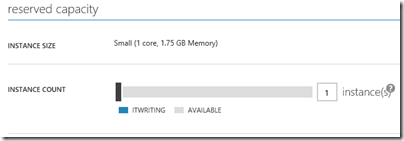Is Microsoft Azure now a billion dollar business? Maybe, maybe not. The milestone was announced by Curt Anderson, CFO for Server and Tools at Microsoft, in this Bloomberg piece:
Microsoft Corp. (MSFT)’s Windows Azure software and related programs have surpassed $1 billion in annual sales for the first time … Microsoft’s $1 billion sales figure includes Azure, as well as software provided to partners to create related Windows cloud services, Anderson said in an interview.
The remarks have prompted discussion of what exactly makes up this billion dollars of sales. In particular, what is this software sold to partners for “related Windows cloud services” and how much is it worth?
Timothy Prickett Morgan on the Register takes the most sceptical line:
It seems likely, however, that the bulk of that revenue figure comes from peddling Windows Server, Systems Center, SQL Server, and any other wares that service providers, telcos, and hosters have bought to build Windows-based clouds.
It’s hard to imagine it being even a 20-80 split for Azure proper versus Azure-alike, and the ratio is probably something on the order of 10-90 if you put a gun to our head and made us guess. And maybe more like 5-95.
He overstates the case though. Context: Server and Tools earned revenue of over $18bn in the Microsoft’s last financial year ending June 30 2012 and is set to exceed that in 2013. As Mary-Jo Foley reports here, System Center (which forms the basis for Microsoft’s “private cloud” offering) was already over $1bn last year, so it seems unlikely that Anderson would now lump System Center revenue in with Azure and call it Azure revenue.
At the same time, the qualification in Anderson’s statement does imply that Azure on its own, without this “software provided to partners” does not quite make it.
It matters little. It is clear to me that Azure is a rapidly growing business for Microsoft, and that the energy put in by Scott Guthrie and his team is paying off. Check his blog for a stream of strong announcements.
Server and Tools boss Brad Anderson told me that Azure is a “massive public cloud that doubles every six months.”
It makes sense too. If your business runs on Microsoft’s platform and you want to scale into the cloud, Azure is a strong contender now that its usability and features are maturing. Azure Virtual Machines, providing infrastructure as a service, are of key importance; note that while they have been available for a while they only came out of preview officially on April 16th, a couple of weeks ago. Azure Active Directory and the possibility of federation with on-premise AD is another critical feature, and so is virtual networking, which became generally available at the same time as the Virtual Machines.
On the other hand, Prickett Morgan’s response and other exclamations of surprise around the web (Say What? says Gigaom) show the extent to which Microsoft botched the Azure launch back in 2008 and 2009, and how far it has to go before it is perceived as a strong cloud platform contender beyond the circles of Microsoft partners.
Amazon Web Services on the other hand won its cloud reputation years ago and shows no sign of letting go of its lead, with energetic development of its platform that at least matches Microsoft’s efforts as well as commodity pricing.
Still, with both Office 365 and Azure now booming, it seems to me that the time when you could laugh off Microsoft’s cloud efforts has passed. Expect an unqualified $1bn revenue for Azure before too long.















